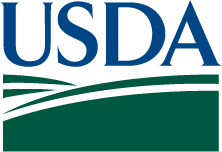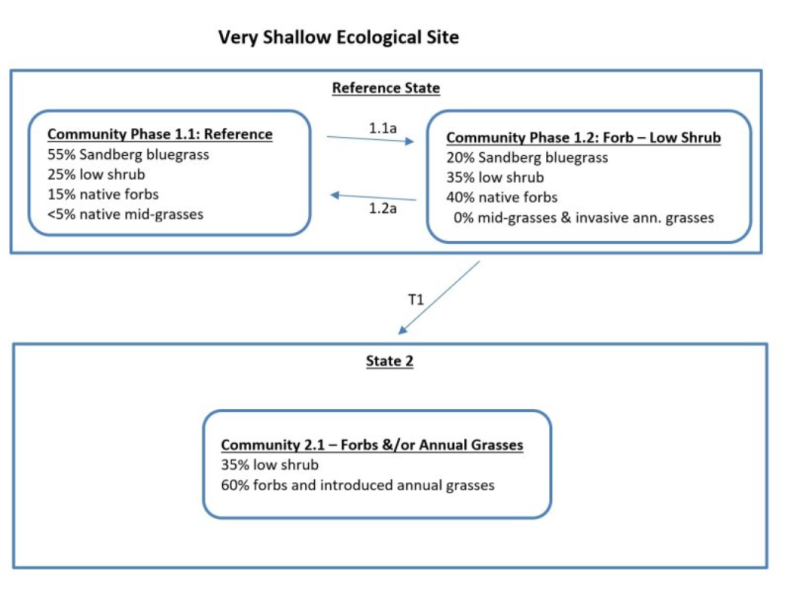Ecological dynamics
Very Shallow produces about 100 to 250 pounds per acre of biomass annually.
The Very Shallow ecological site in MLRA 8 has at least four different variations on the low shrub-shortgrass theme for the Reference community. Sandberg bluegrass is co-dominant in every variation:
1. Stiff sagebrush and Sandberg bluegrass
2. Stiff sagebrush, thyme-leaved buckwheat, rock buckwheat, and Sandberg bluegrass
3. Thyme-leaved buckwheat and Sandberg bluegrass
4. Narrowleaf goldenweed (Stenotus s.) and Sandberg bluegrass
In the spring this site has a rich diversity of native annual and perennial forbs on most sites. Very Shallow supports edible species that have been an important food source for the Native Americans for many generations. Bitterroot and biscuitroot are the main species harvested for food.
Sandberg bluegrass is a shallow-rooted, perennial bunchgrass, perfectly suited to Very Shallow sites. It has short leaves and a green to purplish panicle seed head. On most sites, Sandberg is an understory grass, but on Very Shallow it is the dominant grass. It begins growth in the fall then grows rapidly in the spring and sets seed before moisture is gone. Sandberg bluegrass is resistant to drought, grazing, trampling and fire.
Stiff sagebrush is strongly scented with the characteristic sage odor. It is low and spreading with a conspicuously woody base. The base is often heaved from the soil by frost action. The trunk is very irregular, spreading above the base in a dense cluster of short, rigid, and rather brittle branches up to sixteen inches in length. Stiff sagebrush leaves are forked into three deep lobes like fingers. Unlike other sagebrush species, the leaves of stiff sage are deciduous, and by fall, all of the leaves have dropped. The ground under each plant will have a pile of dead leaves.
The Goldendale Prairie has more precipitation (14 to 20 inches) than anywhere else in MLRA 8 and, has been highly disturbed by farming practices. Thus, Very Shallow sites on the Goldendale Prairie are dominated by cheatgrass (Bromus tectorum), medusahead (Taeniatherum caput-medusae), North Africa grass (Ventenata dubia) or bulbous bluegrass (Poa bulbosa). Lomatium or other native forbs are prominent as well.
Very Shallow is resistant to most natural disturbances and ecologically stable. However, if this site does experience a major disturbance it is not resilient and may be extremely difficult to stabilize once altered. For example, vehicle traffic when the soil is saturated will leave ruts that remain for years to come.
The vegetative cover is too low to carry fire, so these sites rarely burn. In many pastures, due to surface rocks and limited forage, Very Shallow sites are not attractive to grazing animals and so receive only incidental grazing. Based on inherent protection from both fire and grazing, most Very Shallow sites are stable.
For more grazing management information refer to Range Technical Notes found in Section I Reference Lists of NRCS Field Office Technical Guide for Washington State.
In most years, many bunchgrasses remain dormant in the fall. Sandberg bluegrass, however, greens up every year. And so, from late fall through winter and into early spring these Very Shallow sites provide important green forage for deer, elk and upland birds. But these sites also dry up sooner than adjoining sites due to the very shallow soil depth. Grasses are dry from May through September.
State 1
Reference
The Reference state represents non-invaded communities composed of native species. Invasive annual grasses are not present. Very Shallow sites rarely burn, and in most cases, receive minimal grazing. This ecological site is the most stable ecological site on the landscape. The Reference state has 2 communities: 1.1 Sandberg Bluegrass and Low Shrub and 1.2 Forb and Low Shrub. The Reference state species include Sandberg bluegrass, stiff sagebrush, and/or other low-shrub Eriogonum species
At-risk Communities: • All communities in the Reference state are at risk of moving to State 2. The seed source of cheatgrass is nearby and blowing onto most sites annually • Community 1.1 has a high Sandberg bluegrass cover and is thus, at lower risk of moving to State 2, Forb-Annual Grass • Community 1.2, has less Sandberg bluegrass cover and a high amount of forb cover, and is at considerable risk of moving to State 2
Community 1.1
Sandberg Bluegrass and Low Shrubs
Reference community 1.1 is the classic Very Shallow, dominated by Sandberg bluegrass with one or more low shrub species. The low shrub component may be stiff sage and/or one or more Eriogonum low-shrub species.
Community 1.2
Native Forbs and Low Shrubs
Community 1.2 represents a phase that is quite rare in most of MLRA 8. The species are native, but Sandberg bluegrass has a diminished presence while forbs are more prominent. Community 1.2 still has enough Sandberg bluegrass present, to shift back to Reference community 1.1.
Pathway 1.1A
Community 1.1 to 1.2
Result: Shift from Reference Community (Sandberg Bluegrass and Low Shrub) to Community 1.2 (Native Forbs and Low Shrubs). Sandberg bluegrass has been much reduced but remains in the community. The native forb component has increased. There may be a few invasive forbs. Primary Trigger: heavy spring grazing pressure (heavy to severe grazing intensity) to Sandberg bluegrass. The grazing pressure can come from elk, cattle or feral horses. Ecological process: consistent spring defoliation pressure on Sandberg bluegrass causes poor vigor, shrinking crowns and mortality. Grass roots begin to die, and this opens the soil for native forbs to increase via seedlings. The hoof action by large ungulates can disturb the soil surface enough to make them vulnerable to annual grass and forb invasion. Indicators: decreasing Sandberg bluegrass cover and increasing cover of native forbs.
Pathway 1.2A
Community 1.2 to 1.1
Result: Shift from Native Forbs and Low Shrubs community back to the Reference Community. Sandberg bluegrass reestablishes dominance over the native annual forb component as it exerts competitive advantage for resources and space. So, Sandberg bluegrass displaces the forbs to become co-dominant with the low shrub component. Primary Trigger: Defoliation pressures are removed, allowing Sandberg bluegrass to recover and reestablish dominance over the forb component. Ecological process: With reduced grazing pressure Sandberg bluegrass experiences increased plant vigor and root production, expanding its size and competitive abilities through seedlings and tillering. Soils stabilize with the removal of the hoof action and increased volume of roots.
State 2
Forbs and/or Annual Grass
Narrative: This state represents the ecological changes that occur when there is a shift from dominance by perennial native grasses to forbs or annual grass dominance in the herbaceous layer. The shrub components generally remain in the overstory. Most Very Shallow sites never cross the threshold into State 2 as they are not attractive to grazing animals and rarely burn (limited forage values and surface rocks). The exception being chronic heavy grazing in the spring from migrating elk, feral horses or livestock. As the cover of Sandberg bluegrass significantly declines the site becomes open to invasion by invasive annuals, however. Invasive annual grasses, which are common & frequently dominant on adjacent Loamy ecological sites, do not often compete as well on Very Shallow sites. However, the cheatgrass seed blows onto Very Shallow sites annually and can become a minor component. In a year with heavy snowfall and early spring rain, such as 2017, the site had far more moisture than the plant community could utilize. This is the perfect opportunity for cheatgrass seed, which is capable of rapid germination and growth to establish in significant amounts across the site. In the following years when moisture is normal or below normal, native species will utilize most of the available moisture and cheatgrass seed will not germinate or make viable plants. Therefore, in most cases, these micro-bursts of cheatgrass tend to be episodic and mostly a temporary condition on Very Shallow sites. However, due to long-term disturbances and higher precipitation, Very Shallow sites in the Goldendale Prairie portion of MLRA 8 are now dominated by cheatgrass, medusahead, ventenata, or bulbous bluegrass. Sites have been significantly impacted by heavy grazing pressure from livestock that have removed much of the native grass components, leaving niches for these invasive annuals to take hold. Native forbs such as Lomatium may be prominent, but the grass component has shifted completely. A reduction in Sandberg bluegrass cover allows annual grasses the opportunity to colonize and invade on a more permanent basis. Heavy grazing use disrupts the soil surface and the moss-lichen layer via animal hooves, which in turn, causes loss of both soil structure and biological crust. When this happens, site resistance to erosional forces is greatly diminished as well. State 2 may exhibit either a significant decrease in pedestaling due to the lack of bunchgrass cover and heavy use trampling by ungulates, or there will be a significant increase in pedestaling due to increased erosion from water flows around the remaining bunchgrasses. Communities for State 2: Community 2.1: dominated by native forbs and/or invasive annual grasses. Forbs that increase in the altered conditions and are competitive with invasive grasses, can include lomatium, fleabane (Erigeron sp.), willowherb (Epilobium sp.), yarrow (Achillea millefolium), and onion (Allium sp.). Typical invasive grasses may include annual bromes, medusahead, and sixweeks fescue (Vulpia octoflora).
State 2 is considered non-reversible. Restoration of Sandberg bluegrass, the low shrub component, native forbs, and the soil biotic crust would be extremely difficult, labor intensive, and costly. Seedlings and plugged plants need soil moisture and time to germinate and become established. In most years, seeds and plugs may not have a chance as site conditions on Very Shallow can change quickly and the non-native species are much more adaptable under these conditions. Drying winds and bright sun can turn a snowy or muddy site into a hard crust before plants are established. Timing of all recovery efforts would have an extremely narrow window of opportunity on these altered sites of Very Shallow.
Community 2.1
Forbs and Annual Grasses
Community 2.1: dominated by native forbs and/or invasive annual grasses. Forbs that increase in the altered conditions and are competitive with invasive grasses, can include lomatium, fleabane (Erigeron sp.), willowherb (Epilobium sp.), yarrow (Achillea millefolium), and onion (Allium sp.). Typical invasive grasses may include annual bromes, medusahead, and sixweeks fescue (Vulpia octoflora).
Transition T1A
State 1 to 2
Result: Shift from Reference Community Phase 1.1 to State 2 Community Phase 2.1, resulting in the shift in functional groups to forbs and non-native annual grass dominance. Primary Trigger: Extensive spring grazing with heavy use to Sandberg bluegrass. The grazing pressure can come from elk, cattle or feral horses. Secondary Trippers: a micro-burst of cheatgrass could put Community 1.2 at risk. The trampling of Very Shallow soils, displacing and disturbing the surface soil structure by grazing animals could also trigger transition to State 2. A micro-burst of annual grasses could allow even pristine sites to be invaded. Community 1.2 is the community most at risk and is also the pathway for crossing the threshold from State 1 to State 2. Ecological process: consistent spring defoliation pressure to Sandberg bluegrass causes poor vigor, shrinking crowns and plant mortality. Most or all Sandberg bluegrass plants are lost from the community, and this allows native forbs to increase and invasive annuals (forbs and grasses) to colonize and expand. This facilitates plant community changes from Community 1.2 to Community 2.1. Indicators: Declining vigor and cover of Sandberg bluegrass, declining soil biotic crust and, increasing gaps between perennial bunchgrasses.

